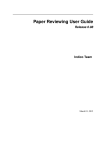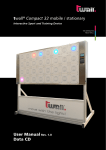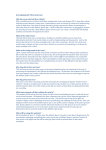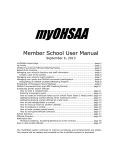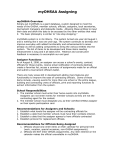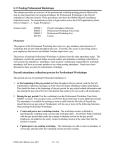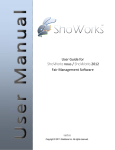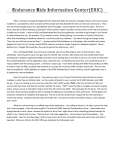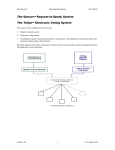Download AOE/ARES Notes - SASA North District
Transcript
Assessment Briefing Notes AOE Operators – ARES21 Candidate Notes This assessment is designed to test the ability and knowledge of AOE Operators for the Omega Ares 21 system. The candidate should have knowledge of the basic components and functions of the AOE system in order to assist in fault-finding during operation and start up. A good knowledge of all connections necessary for the successful operation of the equipment will be required, especially where portable harness is in use, whether set up by the pool management or an AOE installer. The candidate should be able to demonstrate an understanding of the FINA rules regarding the use of AOE equipment. The AOE operator should receive an updated programme or start sheet prior to the commencement of each session. Pre-Assessment Requirements. All candidates for training and assessment as AOE operators must be able to comply with the following: 1. Be an SASA Registered Timekeeper. 2. Conversant with operation of a PC under a Windows environment. Prior to assessment the candidates must complete the following: Complete an Understudy/supervised practice period supervised by a Graded AOE operator. There is no time limit to this assessment however it should be completed within a reasonable time scale set down by agreement between the candidate and the Assessor/ AOE Operator/Trainer. Each candidate will be appointed a trainer at the start of their training and an independent assessor will be appointed once they have applied for assessment. Page 1 The Candidate should demonstrate the ability to: Start up the system from power on. Test the system after assembly or break in competition. Populate the race timetable correctly. Prepare for the race. Provide the Referee with a time and/or place for each competitor in a race Be capable of modifying the result in the event of any failure taking place. Be capable of identifying the cause of an inaccurate result. Complete basic fault finding (incorrectly assembled equipment, Faulty buttons etc) Provide the spectators with the race results via the scoreboard. Achieve all of these functions quickly and accurately. Shut down the system correctly on completion of the competition. Notes: Extracts from the relevant sections of Fina rules relating to AOE and from the Referees notes are reproduced at the end of this document. It should be noted that the ARES interface operates on 12volts DC only. The object of the assessment is to ensure the candidate can: Switch on the equipment and perform set-up checks. Prepare the equipment for the start of a race. Obtain placing and/or times for the swimmers in the race. Adjust times as required by the referee. Maintain the integrity of the system during an event. Page 2 ELECTRONIC TIMING – OPERATING INSTRUCTIONS The following instructions are based on the Omega ARES 21 system. A full set of operating instructions is available in the user manual accompanying the ARES software. The Object of having electronic timing is to provide the accurate placing and times necessary to suit modern day competition. No World Records can be accepted without it and most national and other records require it. The operation of the equipment must be completed quickly and accurately. All functions on the ARES 21 can be completed either by using the pull down menus or by keyboard shortcut OMEGA ARES21 TIMING SYSTEM Connection to the Ares Check the connections from the ARES21 to the PC Power up the PC and switch on the IF Ares. If the ‘ARES21 does not respond’ message appears check the following: 1. ARES21 switched on 2. Power Supply Connected 3. RS-232 cable correctly fitted between the ARES21 PC port and the PC Serial Port (Com 1) Once checked click <Retry>. If still not successful then recheck. If successful the Create Directory window appears. Either create new directory for current session or retrieve from database. Click <OK> Main Window will appear with the Timetable and Event windows. Leave Timetable visible, but Event window can be hidden pressing <F6>. In Main select IF Ares Synchro. In Synchro box enter the correct time. Under source select Direct then click on <GO>. This will now enter the correct time. Note: If-Ares can only be synchronised once. If you need to correct it you will need to switch the IF-Ares off and then back on. Configuring the IF-Ares. You now have to configure the system. Page 3 In Main select Configure. Pool In Pool Config. Window set the following options: 1. 2. 3. 4. Deck cabling Near End Only (25m pool) Harness Position Near Lane (HA1) at Left Pool Length / Number of Lanes Lane Numbering (i.e. Module 1 with Lane 1) Note: if using a 10 lane pool or 8 lanes of a 10 lane pool you can use factory settings. Select Contact. Ensure that Near, Touchpad and Button 2 are selected. Ensure that Start system (normally Closed) is selected <OK> Select <OK> to leave Pool Configuration. In Main select Configure. Precision Default should be set at 1/100th <OK> In Main select Configure. Scoreboard. Set lines per page according to number of scoreboard panels available. Set Hold time per page if number of panels is fewer than lanes in pool. i.e. 3 Panels in a 6 lane pool. <CLOSE> In Main select Configure. Lane Options Set Clear after X seconds to the length of time you want the split times to stay on display before clearing. (Usually about 10secs) <OK> In Main select Configure. Reaction Times This sets up the Platform reaction times (normally only for Relays) In Main select Configure. Pool Page 4 Click on <TEST>. This allows the operation of all Pads, Buttons, and Platforms (if Reaction Times are set on) and Start system to be tested. As each is pressed a coloured panel appears on the screen indicating what has been activated. After checking all the inputs select <EXIT> <OK> In Main select DH This allows you to activate Data handling if using a meet management computer. Entering Session Details: You now have to enter the session event details. Highlight the Timetable Window. <Edit Competition> This opens the Edit competition Window. Enter the details of the first event as per the headings and then click <OK>. Repeat this for all the events of the session. Starting Competition: In Timetable highlight the event and heat number of the first race and then click <RACE>. This opens the Race and Results windows. Examples of these are below: Race Window Page 5 Arm Status: Results Window. The action of selecting Race, automatically arms the start. If you wish to change the Delay time on the Arm then select in the Race window Options Arm Delay. In the After Start box set the delay time (Secs). Usually 15 to 20 Secs depending on the pool. If there is a lot of backwash then set a longer delay time. Manual Arming: Although Arming is automatic it can be overridden by the following in the Race Window: Actions Arm On/ Off/ Auto. This affects all the lanes. Right click on the individual lane and selecting Arm On / Off affects only that lane. At End of Race: On signal of acceptance by Referee the following actions should be taken 1 2 3 Freeze Scoreboard <Ctrl Page Up> Print Result <F12> Reset for next Heat or Event. a. For next Heat <Ctrl N> b. For next Event <Ctrl T> Note: The Race Window must be highlighted to reset for the next heat or event. After the start reset the Scoreboard by pressing <Ctrl Insert> Page 6 Procedures to make corrections to results etc. To clear scoreboard: <Ctrl Home> To Insert Back Up Time: RT Click on Lane in Race Window Take Back Up Or RT click on Lane in Results window Take Back Up To Insert Touch: RT Click on Lane in Race Window Lap +1 To Erase Touch: RT Click on Lane in Race Window Lap -1 To Edit Finish Time: RT Click on Lane in Race Window Edit Finish Time, enter time with no punctuation i.e. 024567 for 02.45:67. <OK> To Disqualify lane RT click on lane in Results window Disqualify (this only to be done on instructions from referee <F12>) To Restart after False Start: Select <Arm Start> If you start the Wrong Race: Quit the Race Window Select the Correct race from the Timetable Window Race. In the Race Window Actions Retrieve Race. This will reset the start to the right race. If you miss the start: This means that the heat was not connected to the race at the start. In the Race Window Actions Retrieve Race OK F6 to restore the Events window Select the Start Event (normally the first on the list) activate this by selecting Actions in the Events window Validate F5 B Returns you to the Race Window. If you process the wrong event you can Cut and Paste the results to the right location. 1. Select the heat from which you wish to take the results from. <Ctrl C> 2. Select the heat in which you wish to place the results <Ctrl V> Page 7 Extracts from FINA Rules and Referees Notes relating to AOE. SW 11 TIMING SW 11.1 The operation of Automatic Officiating Equipment shall be under the supervision of appointed officials. Times recorded by Automatic Equipment shall be used to determine the winner, all placing and the time applicable to each lane. The placing and times so determined shall have precedence over the decisions of timekeepers. In the event that a break-down of the Automatic Equipment occurs or that it is clearly indicated that there has been a failure of the Equipment, or that a swimmer has failed to activate the Equipment, the recordings of the timekeepers shall be official (See SW 13.3). SW 11.2 When Automatic Equipment is used, the results shall be recorded only to 1/100 of a second. When timing to 1/1000 of a second is available, the third digit shall not be recorded or used to determine time or placement. In the event of equal times, all swimmers who have recorded the same time at 1/100 of a second shall be accorded the same placing. Times displayed on the electronic scoreboard should show only to 1/100 of a second. SW 13 AUTOMATIC OFFICIATING PROCEDURE SW 13.1 When Automatic Officiating Equipment is used in any competition, the placing and times so determined and relay take-offs judged by such Equipment shall have precedence over the timekeepers. SW 13.2 When the Automatic Equipment fails to record the place and/or time of one or more swimmers in a given race: SW 13.2.1 Record all available Automatic Equipment times and places. SW 13.2.2 Record all human times and places. SW 13.2.3 The official place will be determined as follows: SW 13.2.3.1 A swimmer with an Automatic Equipment time and place must retain his relative order when compared with the other swimmers having an Automatic Equipment time and place within that race. SW 13.2.3.2 A swimmer not having an Automatic Equipment place but having an Automatic Equipment time will establish his relative order by comparing his Automatic Equipment time with the Automatic Equipment times of the other swimmers. SW 13.2.3.3 A swimmer having neither an Automatic Equipment place or an Automatic Equipment time shall establish his relative order by The times recorded by the Semi- Automatic Equipment or by three digital watches. Page 8 SW 13.3 The official time will be determined as follows: SW 13.3.1 The official time for all swimmers having an Automatic Equipment time will be that time. SW 13.3.2 The official time for all swimmers not having an Automatic Equipment time will be the three digital watches or the Semi-Automatic Equipment time. SW 13.4 To determine the relative order of finish for the combined heats of an event, proceed as follows: SW 13.4.1 The relative order of all swimmers will be established by comparing their official times. SW 13.4.2 If a swimmer has an official time which is tied with the official time(s) of one or more swimmers, all swimmers having that time shall be tied in their relative order of finish in that event Referees Notes: Although, at present, training in the operation of Automatic Officiating Equipment (AOE) is not part of the training programme for a REFEREE it is a requirement that REFEREES have a working understanding of what the AOE can provide in the form of printouts and displays. It is also important to understand what "adjustments" can be carried out by the AOE Operator on behalf of the REFEREE. It should not be forgotten that the REFEREE is responsible for declaring the result and any "adjustment" carried out by the AOE Operator must have been agreed with the REFEREE. With this in mind it is important that the REFEREE and AOE Operator are able to communicate readily - ideally speak directly to each other. Before each session starts the REFEREE must discuss with the AOE Operator the requirements for printouts and displays from the AOE what "adjustments" can be made by the AOE Operator the REFEREE being advised at the end of the race and which adjustments require the REFEREES agreement before being carried out. The REFEREE will ask for the following printouts to be available:1) Result printout to be provided for each race. 2) Back up printout for each race to be available when requested by REFEREE. 3) Split time printout for each race to be held by AOE Operator. A REFEREE will normally only require to see the result printout. If however, there is doubt concerning the swimmers "touch" the REFEREE would request the back up printout to provide additional information for comparison with the human judges placings and human times. Examples of the "RESULT" printout and "BACKUP" printout for an event using eight lanes is given at the back of these notes. The "RESULT" times are those recorded by the swimmer touching the pad at the finish Page 9 of the race. The "BACKUP" times are those recorded by the push button (semi-AOE) operated by a FINISH JUDGE or TIMEKEEPER. The "SEMI-AOE" time is always shown directly below the "RESULT" time. When a time is not recorded "dashes" (---) appear on the printout. All times that have been "adjusted" by the AOE operator in agreement with the REFEREE are indicated by an "" on the printout to the right of the quoted time. The REFEREE will instruct the AOE Operator to clear the display board of information for a lane in which a swimmer has been disqualified after the race has been completed and the result has been confirmed, unless the disqualification is for a starting infringement. The REFEREE will instruct the AOE Operator to insert a "finish" time (ie carry out an adjustment) after "declaring the result" if the AOE has failed to provide the full result. The REFEREE will normally agree at the beginning of each session that the AOE Operator can make adjustments to split times without consulting the REFEREE but must not adjust "finish" times in advance of being instructed by the REFEREE. The REFEREE will advise the AOE Operator when the result is official and that the display board can be activated to give the result. This is achieved when using a multi lane display by changing from "lane order" to "result order". For a single lane display this is achieved by "rolling" the information in "result order". It is essential that when AOE is used that the REFEREE and the AOE Operator are working together and have a clear understanding of each others responsibilities and requirements. When pressure pads on starting blocks are used in conjunction with the lane touch pads to provide "TAKE OVER" information during relay events a printout giving any negative figure (ie -0.065) indicates a faulty take over (a "flyer") would lead to the team concerned being disqualified. Note OMEGA give their tolerance of their equipment as 0.03 which FINA have accepted. (-0.03 is OK –0.04 is a flyer) Page 10










